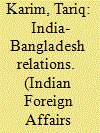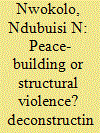| Srl | Item |
| 1 |
ID:
141366


|
|
|
|
|
| Summary/Abstract |
During the last six years, India and Bangladesh have surged ahead steadily in multiple sectors. Security cooperation between the two has never been better; indeed it is exemplary. Both have amicably resolved disputes, and completed the boundary demarcation on the land, in rivers, and in the Bay of Bengal. India has unilaterally extended duty free and quota free access to virtually all but 26 Bangladeshi products in the Indian market, resulting in a substantial increase in the volumes of bilateral trade. Eight border haats (markets) have been set up, to date, along Bangladesh’s borders with Meghalaya and Tripura, thus reconnecting and reviving historic economic connections that had existed between peoples and communities on both sides before they were disrupted. Many more are under active consideration. Indian investments in Bangladesh have surged dramaticallyinitially in the garments and textiles as well as telecom sectors, and now expanding steadily into the power and infrastructure sectors also.
|
|
|
|
|
|
|
|
|
|
|
|
|
|
|
|
| 2 |
ID:
172101


|
|
|
|
|
| Summary/Abstract |
There is a great conviction that the International Court of Justice’s ruling in 2002 on the Bakassi boundary dispute between Nigeria and Cameroon, and Nigeria’s decision to obey the ruling may have stopped a fierce inter-state war over the boundary. Indeed, many then ascribed to the whole boundary demarcation process as peacebuilding, disregarding the structural changes marked by the violence of forced migration. This article explores how the boundary delimitation has produced particular sorts of structural violence characterised by state neglect, loss of livelihoods and destitution. Thus, the article argues that although a full-blown war was avoided, the socio-economic conditions of the Nigerian populations on both sides of the border were not adequately considered and guaranteed as part of the peace-building agenda. It further argues that Nigeria, like many post-colonial states with the concentration of developments in major cities, neglects rural and border communities. Thus, the border communities accommodating the former Bakassi residents have further degenerated into ‘ill-governed’ spaces. This article uses structural violence as a framework to analyse the primary and secondary data to provide some deeper insights into the issues of violence being experienced by the local populations living on both sides of the demarcated border.
|
|
|
|
|
|
|
|
|
|
|
|
|
|
|
|